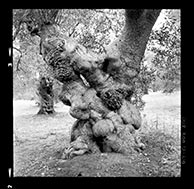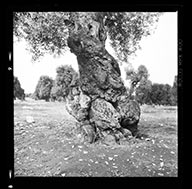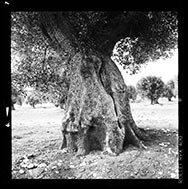Olive Trees
Puglia, Italy
2017-Present
“The ancient road “Via Traiana” (built under the dominion of the emperor Traiano about 2000 years ago) links Rome with the harbor of Brindisi and the east. The roadway helped develop the trade in olive oil. The Traiana route passed different ports where boats full of jars containing this precious yellow gold sailed towards north Italy and northern Europe.”
– Millenari di Puglia, an organization that safeguards olive trees
For decades my work on commodities has taken me far afield. Currently I am looking at the production of olive oil in Puglia. Wild olives are indigenous to Puglia; cultivated olive trees, which produce larger olives (from Middle Eastern cultivars), were introduced in Puglia by the Greeks thousands of years ago. The region accounts for about 40% of the olive oil production in Italy and many of the trees are ancient, a thousand years to three thousand years old.
The old trees have taken on fascinating forms, the result of both natural and man-made forces. Like all trees, the olives respond to light, and they are also buffeted and shaped by the strong winds off the nearby sea. But, with age, parts of the trees die off. Historically the caretakers have cut out the dead wood. The tree then directs new growth towards the newly opened space, causing it to twist and turn as it does so. For the centuries-old trees this dance between man and nature has been repeated many times, giving the trees spectacularly unique shapes.
I’ve been photographing the trees with my Rolleiflex and soon will be using an 8x10 view camera.



